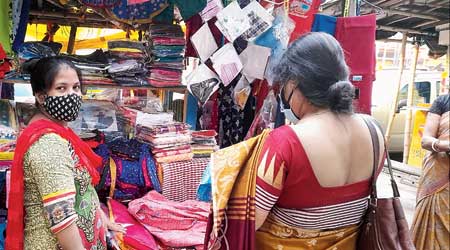The crowd is back in Gariahat and New Market and this is what many small street-side hawkers and the even smaller workforce, which supplies items like trinkets and cloth bags to them, are pinning their hopes on.
Most of them feel the earnings in the run up to the Pujas will help them make ends meet at least through the next six months. Some have taken loans to stock their stalls because unlike other years before the pandemic they had no savings.
Even a couple of months before business was low with hardly any customers, said a woman who has a stall in Gariahat.
But now they can at least see customers coming to the shop, a smaller percentage buys, but hopes soar. They try to add more variety to their tray. And these few days before the Puja will decide whether they will be able to pay the tuition fees of their children, buy new clothes for them and keep the home running.
Last year, the Durga Puja sale was dismal with not many people ready to buy and the repercussion of that has been far reaching.
Even around 10 days back their shops were not as crowded though the weekends were better. But with nine days to Puja, on Saturday, they had no time to speak.
“Almost all the stock of last year was unsold. But this year there is hope. I have also taken Rs 8,000 as loan and bought new stock,” said Ashima Dey who sells saris, accessories and kurtis near Deshapriya Park.
Dey, who keeps saris in the range between Rs 350 and Rs 1,000, said on a good day she sold about 10 to 15. “I also sell blouses and kurtis. Many stalls keep similar things so if I don’t have the latest stuff why would customers come to my shop,” said the mother of two school-going girls.
During Puja at least customers come to the shop.

Manika Sumitra Patra stitches at her home in Tijala
“If customers come then we can at least bargain and sell,” said a hawker, who sells trinkets in New Market.
Unlike other times of the year before Puja there is a tendency to spend and in many homes they try to keep a certain amount of money aside for shopping.
Calcutta Social Project that provides interest free loans under a project it launched last year has provided loans to about 25 hawkers in the last one month.
“Almost all of them who came to us were desperate to buy stock. They told us that if they cannot sell now they will lose a major income,” said Arjun Dutta, the president of Calcutta Social Project.
Even a street corner shop wants to restock with more chips and cold drinks hoping that the shopping and pandal hopping would push up their sales as well.
But with the pandemic still looming large there are risks not many are willing to take.
For example Manika Sumitra Patra is stitching salwar kurta sets, blouses and masks at nominal rates.
“I am charging Rs 120 for a salwar set and Rs 150 for a blouse. If I charge more I might not get enough orders, at least now I have some,” she said.
Patra’s husband who worked as an electrician in an office was laid off last year. Now he has no regular job but his income is dependent on when he gets a call.
Patra also makes masks in bulk for Rs 8 to Rs 10 a piece and a supplier takes it from her.
“The cloth is provided and I have to pay for the elastic so I earn about Rs 4 to Rs 5 from each mask. In one metre of cloth I can make 25 and the best part is because it is festive season demand is more so I am trying to make the most of it,” she said.
Patra said if there was some money left after keeping aside the necessities, she would be able to buy new clothes for her seven-year-old daughter.
